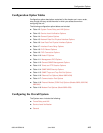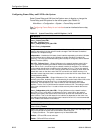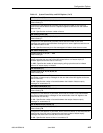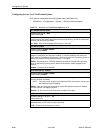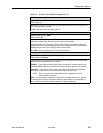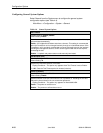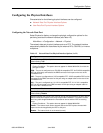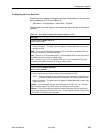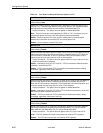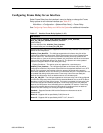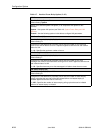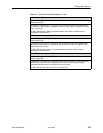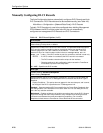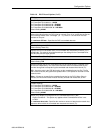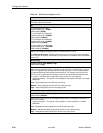
Configuration Options
4-21
9820-A2-GB20-20
June 2000
Configuring the User Data Port
Select Physical to display or change the physical characteristics of the user data
port connected to the DTE (see Table 4-6).
Main Menu
→
Configuration
→
Data Ports
→
Physical
The data rate of the user data port is automatically set to the rate of the network
interface.
Table 4-6. User Data Port Physical Interface Options (1 of 2)
Port Type
Possible Settings: E530, V.35, X.21
Default Setting: V.35
Selects the type of port to be used for the user data port.
Display Conditions
– This option does not appear for Model 9820-45M, for which the
port type is HSSI.
E530 – The port is an EIA-530-A-compatible DCE. An EIA-530-A-compatible DTE can
be directly connected to the DB25 connector.
V.35 – The port is a V.35-compatible DCE. A V.35-compatible DTE can be connected to
the DB25 connector by using an adapter cable.
X.21 – The port is a V.11/X.21-compatible DCE. A V.11/X.21-compatible DTE can be
connected to the DB25 connector by using an adapter cable.
Transmit Clock Source
Possible Settings: Internal, External
Default Setting: Internal
Determines whether the DTE’s transmitted data is clocked into the FrameSaver unit by
its internal transmit clock or by the external clock provided by the DTE.
NOTE: Changing settings for this configuration option causes the FrameSaver unit
to abort any physical port tests, including any DTE-initiated loopback tests.
Display Conditions
– This option does not appear for Model 9820-45M, or when Port
Type is set to X.21.
Internal – The FrameSaver unit uses the interchange circuit DB (ITU 114) – Transmit
Signal Element Timing (TXC) (DCE source) for timing the incoming data.
External – The DTE provides the clock for the transmitted data, and the FrameSaver
unit uses the interchange circuit DA (ITU 113) – Transmit Signal Element Timing (XTXC)
(DTE source) for timing the incoming data.



